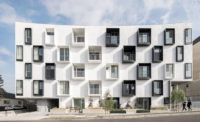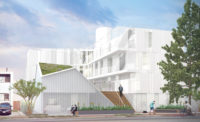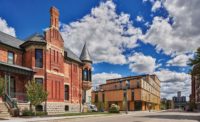Los Angeles’ reputation as a reluctant metropolis—a city without much in the way of urban lifestyle—has been well deserved. Just 15 years ago, you’d be hard-pressed to describe its most densely built areas as residential (or desirable). Fed by the culture of freeways, the city’s predominant housing type has been the quasi-suburban sprawl of single- or two-family houses, intermingled with “dingbats,” those small, boxy, cheaply constructed buildings with a couple of stories of apartments over grade-level parking and grandiose names such as “The Capri” or “La Traviata.”
Just last year, one of those tight midblock parcels became the site of Cloverdale749, a condo building designed by Lorcan O’Herlihy Architects (LOHA) in the Miracle Mile, or Mid-Wilshire, district. About 3 miles from Downtown and within walking distance of Museum Row, the structure occupies a transitional edge between a neighborhood of freestanding houses and a major commercial corridor.
Modestly scaled yet decisively urban, the project began with a query from the client: Could LOHA find a way to fit more than four units comfortably within the 6,700- square-foot lot? “This is the kind of question we’re pretty experienced with,” says principal Lorcan O’Herlihy. “LOHA has been very interested in L.A.’s urban culture—in the discussion about how the city is changing significantly.”
Analyzing the zoning and code parameters, his team designed a four-story, 11,000-square-foot building with a total of six units, each spanning two floors. Below-grade parking, deftly configured to pack in the 12 required spaces, was essential to the solution.
For O’Herlihy, however, it wasn’t just a matter of maxing out the lot, but also of creating homes with individual thresholds to the outdoors—and layers of privacy within the city. So Cloverdale749 fills the allowable building envelope, except where LOHA recessed the blocky volume to give each grade-level apartment its own small entry court, or outdoor vestibule. The trade-off: a small sacrifice in square footage in exchange for a substantial gain in the quality of the experience. Edged by windows, these semiprivate areas open the interiors to breezes and daylight from multiple exposures.
As in LOHA’s previous multifamily buildings, Cloverdale749 has no internal corridors. Instead, the circulation was pushed to an exterior edge, promoting spatial efficiency, also allowing cross-ventilation through the units, all of which extend the entire width of the floor plate. (The three upper apartments also have private roof decks, permitting additional airflow through the roof bulkhead.)
In advancing passive cooling while modulating levels of privacy, the cladding strategy was also instrumental. LOHA wrapped the wood-framed building in corrugated steel panels, both perforated and solid, creating a nuanced composition from off-the-shelf industrial siding. Veil-like, the porous material simultaneously conceals and reveals: discreetly screening balconies along the street facade, it offers views out but not in. The diaphanous skin both defines the building volume and visually dematerializes it— a tension that shifts with the daylight and, by night, with illumination from within. And, in purely practical terms, the sheer layer shades the interior (even with great expanses of glazing), minimizing heat gain while ushering in breezes.
O’Herlihy has experimented before with facades of solid and perforated metal panels on Los Angeles apartment buildings, most notably at Formosa 1140. But there, horizontals play energetically against verticals in a vibrant red-and-orange facade. By contrast, Cloverdale749 has an almost entirely white-on-white palette and an exterior composition accentuating the vertical rhythms of the pleated and fluted metal panels (with a nod, says the architect, to the elongated lines of a vintage Art Deco tower nearby).
Cloverdale749’s striking whiteness (with deep-brown stucco in the shadowy recesses) was also influenced by its context—but, in this case, was chosen as an antidote, says O’Herlihy, to the “ubiquitous beige or yellow” of neighboring apartment buildings. This isn’t a faux Tuscan villa, currently the favored model for small condo buildings in Los Angeles, but a work in pure-white, clean-edged metal, celebrating, as he puts it, “the Modernist ethos.”
Rather than striking a single note, however, this minimalist palette becomes a foil for the play of light and shadow across the facades’ vertical ridges and patterns of perforation. And instead of repeating a formulaic rhythm over the elevations, LOHA allowed the unique conditions of each unit—views, adjacencies, exposure to sunlight, and point of entry—to dictate varied design decisions that, in turn, animate the exterior composition.
Inside, the apartments have lofty ceilings (just under 10 feet), open plans in the main living spaces, wide-plank oak floors, dark wenge kitchen cabinets, and daylighting through the extensive glazing, as well as clerestory windows.
The client and architect anticipated these condos’ attracting 30- or 40-something buyers in creative lines of work, and that prediction has hit close to the mark. Current owners include people in graphic design and screenwriting, and other areas of the film industry. Even during construction, the project drew local attention. One couple living down the street, for example, tracked its progress from the start and snapped up a unit as soon as it was ready. All the condos, ranging in size from 1,500 to 1,800 square feet, sold well, fetching up to $900,000, with the quality of the design commanding higher prices than similarly sized nearby units.
“The influx of accomplished, relatively young people choosing to live in the city seems to be driving a demand for quality design,” says the architect. “You can take great ideas from single-family houses and apply them to apartments, but that wasn’t always the expectation in Los Angeles. Now clients are saying, ’I want good architecture, not flimsy stucco boxes with tacked-on windows.’ ”
With its attention to detail and invention, authentic materials, and individualized solutions, Cloverdale749 may be part of an emerging new breed. Born in the Los Angeles sunshine, it is, in many respects, the anti-dingbat—until now an exceptionally rare species in this town.
PeopleClient: Architect: Personnel in architect's firm who should receive special credit: Interior Designer: Engineers: Mechanical and Plumbing: Electrical: Civil: Consultant(s): General contractor: Photographer(s): Size: 11,000 square feet Construction cost: $2.6 million Completion date: May 2014 |
ProductsStructural system Exterior cladding Moisture barrier: Roofing Elastomeric: Glazing Doors Sliding doors: Hardware Pulls: Interior finishes Paints and stains: Carpet: Special interior finishes unique to this project: Furnishings Lighting Conveyance Plumbing |













